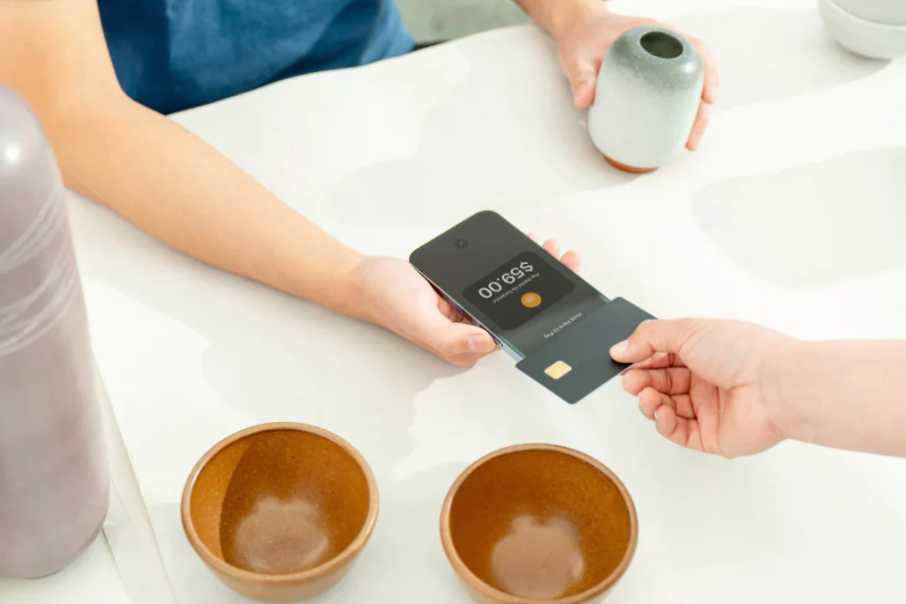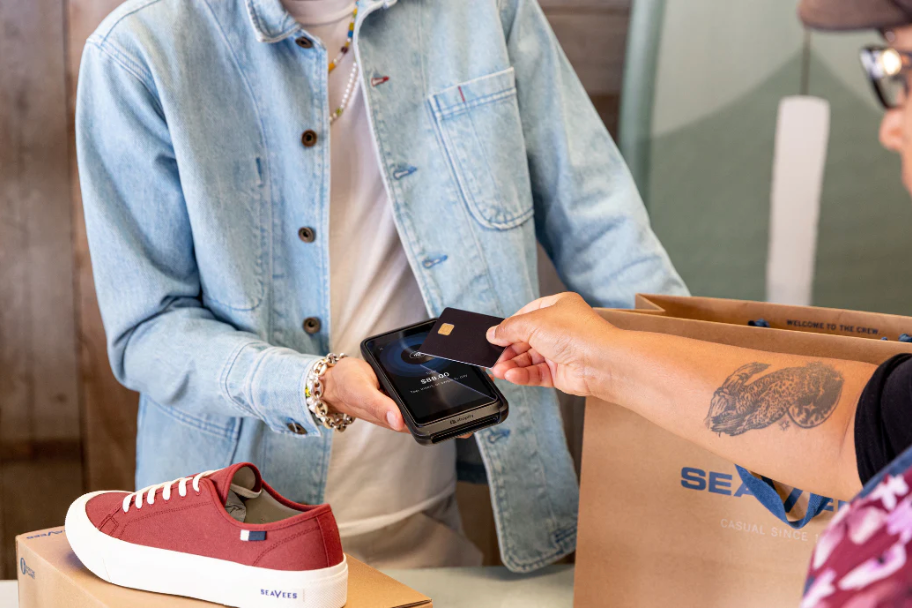For decades, credit and debit card payments were viewed with caution due to concerns scammers would steal information.
Near field communication (NFC) technology has changed the game. NFC works with chip-enhanced credit cards and mobile devices, adding convenience and security for more than half of Americans using contactless payments already.
Interested in using NFC and contactless payments? Here's how to decide if they're right for your business, and how to make it happen.
What is an NFC payment?
NFC (near-field communication) is a wireless communication protocol that permits two devices to communicate via a secure low-speed connection. It enables contactless payment processing via payment terminals known as NFC-enabled readers.
NFC mobile technology powers two different payment methods:
- Credit and debit cards. Modern versions of credit and debit cards come embedded with a radio frequency identification (RFID) chip that uses NFC to communicate with payment terminals.
- Mobile phones, tablets, and smartwatches. Mobile wallet apps, which operate via software on a user’s smartphone, smartwatch, or tablet, use the mobile device’s built-in NFC radio to communicate with NFC payment devices. As such, mobile wallet apps can be used the same way credit and debit cards are used in tap to pay transactions.
💡 Shopify POS hardware lets customers tap to pay at the counter, on the sales floor, and on the go.
How do contactless payments work?
NFC mobile payments work by sending encrypted transmissions using near-field communication, a secure, low-speed radio standard.
NFC chips can be found in smartphones, smartwatches, tablets, and even laptops. These NFC devices run mobile wallet apps like Apple Pay, Google Pay, and Samsung Pay. When a customer uses the device to pay for something, their credit card or bank account gets charged.

On the vendor's side of the transaction, point-of-sale (POS) payment terminals double as credit card readers. POS systems talk to NFC devices like they do with chip cards.
With NFC devices, you can't make payments unless you authorize them with your fingerprint, face ID, or passcode.
How to accept NFC and contactless payments
- Set up Shopify Payments
- Get the right hardware
- Choose your payment options
- Tell your customers
1. Set up Shopify Payments
Start by activating Shopify Payments in your store. It’s the easiest way to accept NFC mobile payments through credit cards, Apple Pay, or Google Pay.
2. Get the right hardware
To accept contactless payments, you’ll need the right point-of-sale (POS) hardware. Here are three options:
- Shopify Retail Counter Kit: Includes all necessary hardware for a Shopify POS setup, compatible with contactless payments. This hardware bundle is for brands that want a stationary checkout counter in their retail store. With it, you can accept all payment types including contactless, NFC.
- Shopify POS Go: Shopify POS Go is an all-in-one mobile device for easy, on-the-floor selling. It combines the Shopify POS system with a built-in barcode scanner and card reader. This enables store associates to serve customers and accept card and contactless payments anywhere in a store's showroom.
- Tap to Pay on iPhone: This app is for brands that want to accept payments on-the-go (like at farmer's markets or events) without having to buy hardware. Just download the Shopify POS app on your iPhone to start accepting contactless payments.
💡 Learn how selling at in-person events with Shopify POS helped Daniel Vu take his ceramics business to new levels.
3. Choose your payment options
Go to your Shopify admin dashboard and check the options for Apple Pay, Google Pay, and Shop Pay.
4. Tell your customers
Make sure customers know that you accept contactless payment methods. Use signage at your physical location or suggest it at checkout.

Advantages of NFC and contactless payments
The contactless payment market is booming. Juniper Research predicts that global contactless payment transactions will exceed $10 trillion by 2027.
Here’s what’s driving this payment trend.
Convenience
In a 2021 report from American Express, consumers were asked why they prefer contactless payments. Some 73% cited convenience as the top reason.
NFC mobile payments allow customers to leave their wallets at home. To make a payment, they tap their phone at a point-of-sale terminal.
Immediate processing
According to the same Amex report, 54% of respondents preferred contactless because it's faster transaction speeds. Mobile payment works instantly with NFC. A customer just needs to unlock their phone with a fingerprint, face scan, or passcode to pay for something.
Security
A mobile payment with NFC uses end-to-end encryption. It's also more secure than magnetic stripe payments because users have to unlock their devices and give permission before making a payment. This helps reduce chargeback complaints and provides a better customer experience.
Disadvantages of NFC and contactless payments
It requires special equipment
Merchants must invest in special payment terminals equipped with the right kind of NFC radios to accept NFC payments. In addition to paying for the equipment, the merchant might also pay an electrician to install these terminals in their stores.
Transaction limits
Mobile wallet apps place transaction limits on their users, which can limit cart sizes and purchase amounts. Sometimes these transaction limits fall well below the limits placed on a normal credit card.
It’s only as secure as the user’s device
If a customer loses their mobile phone, or it falls into the hands of someone who knows their passcode, that other person could unlock the phone and make purchases via the user’s mobile wallet account.
To prevent this type of fraud, individuals should secure their internet-connected devices with fingerprints or Face ID, in addition to a password or passcode.
Accept NFC payments for your business
Customers love the convenience of mobile payment apps. Business owners are spotting this trend and adjusting their operations to accept NFC mobile payments.
By adapting to customer preferences, you offer convenience and security to your clients, who, in return, can offer loyalty and appreciation.
Read more
- How to Accept Credit Card Payments In-Store or Online
- Product Packaging Design- Get Your Brand Ahead At First Impression
- Understanding PSD2 and Strong Customer Authentication
- Packaging Inserts Ideas- 7 Ways to Increase Customer Loyalty
- Business Renters Insurance- A Guide for Business Owners
- Ecommerce Accounting for Small Business Owners
- How Recurring Payments Work for Small Business Owners
- From Realtor to Retailer- How Strategic Financing Helped One Entrepreneur Scale Quickly
- Electronic Payment- What Small Business Owners Should Know
- Business Owner’s Policy- Your Guide to Small Business Insurance
NFC and contactless payments FAQ
Does my phone support NFC payment?
Most modern smartphones released in the last few years support NFC. This includes Apple, Samsung, Google, and Huawei. If you're unsure whether or not your phone supports NFC payments, look up your phone model's specifications on the manufacturer's website.
Is it safe to pay with NFC?
Yes, NFC is one of the most secure payment methods available to consumers. The devices use encrypted transmissions in both directions, so scammers can't intercept financial data. Before you can make NFC payments, you need to unlock your device with a passcode, fingerprint, or face scan.
Can I take NFC payments on my phone?
Yes, you can take NFC payments on your phone with Shopify's Tap to Pay on iPhone feature. Simply download the Shopify POS app and add products to the cart. Your phone will become a payment terminal for in-person customers.
How do I pay with NFC?
If you want to pay with NFC, add a mobile wallet app to your phone. You can connect your mobile wallet to your credit card, debit card, or bank account. Popular mobile wallets include Google Pay, Apple Pay, Samsung Pay, Venmo, and PayPal. Once you're set up, you can use NFC at any retailer with an NFC terminal.








